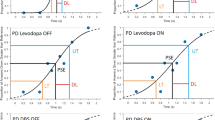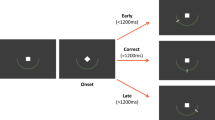Abstract
Alterations in temporal estimation have been observed in patients with Parkinson’s disease (PD) and have been associated to dopaminergic dysfunction. Nevertheless, levodopa treatment and deep brain stimulation of the subthalamic nucleus (DBS-STN) have been shown to improve motor deficits and temporal estimation skills in such patients. So far, temporal estimation tasks in PD patients have evaluated the ability to reproduce intervals of time, but never the duration of an action. Here we investigated: (1) the ability of PD patients to reproduce the duration of their previous actions as compared to their ability to reproduce intervals of time and (2) the effect that DBS-STN has on both skills. Nineteen PD patients with DBS-STN and 19 controls were requested to reproduce the duration of an action and that of an interval of time. The patients were tested in the following treatment conditions: on stimulation/off medication, off stimulation/off medication and off stimulation/on medication. The results demonstrated that patients in the off stimulation/off medication condition under-reproduced the duration of their actions while accurately reproducing the duration of time intervals. The accuracy of the performance improved significantly in both treatment regimens. Our results indicate that in PD patients the ability to reproduce motor acts can be dissociated from that of reproducing time intervals and that it can be improved by the administration of medical or surgical treatment.

Similar content being viewed by others
References
Alberts J, Voelcker-Rehage C, Hallahan K, Vitek M, Bamzai R, Vitek J (2008) Bilateral subthalamic stimulation impairs cognitive-motor performance in Parkinson’s disease patients. Brain 131:3348–3360
Alexander G, DeLong M, Strick P (1986) Parallel organization of functionally segregated circuits linking basal ganglia and cortex. Ann Rev Neurosci 9:357–381
Amanzio M, Monteverdi S, Giordano A, Soliveri P, Filippi P, Geminiani G (2010) Impaired awareness of movement disorders in Parkinson’s disease. Brain Cogn 72(3):337–346
Artieda J, Pastor M, Lacruz F, Obeso JA (1992) Temporal discrimination is abnormal in Parkinson’s disease. Brain 115:199–210
Beste C, Saft C, Andrich J, Müller T, Gold R, Falkenstein M (2007) Time processing in Huntington’s disease: a group-control study. PLoS ONE 2:e1263
Bialystok E, Craik F, Stefurak T (2008) Planning and task management in Parkinson’s disease: differential emphasis in dual-task performance. J Int Neuropsychol Soc 14:257–265
Block R, Zakay D (1997) Prospective and retrospective duration judgments: a meta-analytic review. Psychon Bull Rev 4:184–197
Brown R, Marsden C (1991) Dual task performance and processing resources in normal subjects and patients with Parkinson’s disease. Brain 114:15–231
Buhusi C, Meck W (2005) What makes us tick? Functional and neural mechanisms of interval timing. Nat Rev Neurosci 6:755–765
Charles PD, Gill CE, Davis TL, Konrad PE, Benabid AL (2008) Is deep brain stimulation neuroprotective if applied early in the course of PD? Nat Clin Pract Neurol 4:424–426
Funkiewiez A, Ardouin C, Cools R, Krack P, Fraix V, Batir A, Chabardès S, Benabid A, Robbins T, Pollak P (2006) Effects of levodopa and subthalamic nucleus stimulation on cognitive and affective functioning in Parkinson’s disease. Mov Disord 21:1656–1662
Gibbon J, Church R, Meck WH (1984) Scalar timing in memory. Ann N.Y. Acad Sci 423:52–77
Grosset K, Needleman F, Macphee G, Grosset D (2004) Switching from ergot to nonergot dopamine agonists in Parkinson’s disease: a clinical series and five-drug dose conversion table. Mov Disord 19:1370–1374
Hackney ME, Earhart GM (2009) Health-related quality of life and alternative forms of exercise in Parkinson’s disease. Parkinsonism Relat Disord 15:644–648
Hicks R, Miller G, Kinsbourne M (1976) Prospective and retrospective judgments of time as a function of amount of information processed. Am J Psychol 89:719–730
Jellinger K (1987) Overview of morphological changes in Parkinson’s disease. Adv Neurol 45:1–18
Koch G, Brusa L, Caltagirone C, Oliveri M, Peppe A, Tiraboschi P, Stanzione P (2004) Subthalamic deep brain stimulation improves time perception in Parkinson’s disease. Neuroreport 15:1071–1073
Koch G, Costa A, Brusa L, Peppe A, Gatto I, Torriero S, Gerfo E, Salerno S, Oliveri M, Carlesimo G, Caltagirone C (2008) Impaired reproduction of second but not millisecond time intervals in Parkinson’s disease. Neuropsychologia 46:1305–1313
Malapani C, Rakitin B, Levy R, Meck W, Deweer B, Dubois B, Gibbon J (1998) Coupled temporal memories in Parkinson’s disease: a dopamine-related dysfunction. J Cogn Neurosci 10:316–331
Martin J (1972) Rhythmic (hierarchical) versus serial structure in speech and other behavior. Psychol Rev 79:487–509
McIntosh GC, Brown SH, Rice RR, Thaut MH (1997) Rhythmic auditory-motor facilitation of gait patterns in patients with Parkinson’s disease. J Neurol Neurosurg Psychiatry 62:22–26
Meck W, Penney T, Pouthas V (2008) Cortico-striatal representation of time in animals and humans. Curr Opin Neurobiol 18:145–152
Merchant H, Luciana M, Hooper C, Majestic S, Tuite P (2008) Interval timing and Parkinon’s disease: heterogeneity in temporal performances. Exp Brain Res 184:233–248
O’Boyle D, Freeman J, Cody F (1996) The accuracy and precision of timing of self-paced, repetitive movements in subjects with Parkinson’s disease. Brain 119:51–70
Pastor M, Artieda J, Jahanshahi M, Obeso J (1992) Time estimation and reproduction is abnormal in Parkinson’s disease. Brain 115:211–225
Perbal S, Deweer B, Pillon B, Vidailhet M, Dubois B, Pouthas V (2005) Effects of internal clock and memory disorders on duration reproductions and duration productions in patients with Parkinson’s disease. Brain Cog 58:35–48
Riesen J, Schnider A (2001) Time estimation in Parkinson’s disease: normal long duration estimation despite impaired short duration discrimination. J Neurol 248:27–35
Rochester L, Burn DJ, Woods G, Godwin J, Nieuwboer A (2009) Does auditory rhythmical cueing improve gait in people with Parkinson’s disease and cognitive impairment? A feasibility study. Mov Disord 24:839–845
Taatgen N, van Rijn H, Anderson J (2007) An integrated theory of prospective time interval estimation: the role of cognition, attention, and learning. Psychol Rev 114:577–598
Temel Y, Visser-Vandewalle V, Kaplan S, Kozan R, Daemen MA, Blokland A, Schmitz C, Steinbusch HW (2006) Protection of nigral cell death by bilateral subthalamic nucleus stimulation. Brain Res 1120:100–105
Thomas E, Weaver W (1975) Cognitive processing and time perception. Percept Psychophys 17:363–367
Wallace BA, Ashkan K, Heise CE, Foote KD, Torres N, Mitrofanis J, Benabid AL (2007) Survival of midbrain dopaminergic cells after lesion or deep brain stimulation of the subthalamic nucleus in MPTP-treated monkeys. Brain 130:2129–2145
Wearden J, Smith-Spark J, Cousins R, Edelstyn N, Cody F, O’Boyle D (2008) Stimulus timing by people with Parkinson’s disease. Brain Cogn 67:264–279
Wu T, Hallett M (2008) Neural correlates of dual task performance in patients with Parkinson’s disease. J Neurol Neurosurg Psychiatry 79:760–766
Zakay D, Block R (1997) Temporal cognition. Curr Dir Psychol Sci 6:12–16
Acknowledgments
This study was funded by a “Progetto Alfieri” grant from the Fondazione Cassa di Risparmio di Torino (CRT). The authors would like to dedicate this article to Luca Latini, a friend and colleague. He always helped us all personally and professionally until his very last moments. His scientific and personal contribution to this article has been fundamental. His memory will live with us.
Author information
Authors and Affiliations
Corresponding author
Rights and permissions
About this article
Cite this article
Torta, D.M.E., Castelli, L., Latini-Corazzini, L. et al. Dissociation between time reproduction of actions and of intervals in patients with Parkinson’s disease. J Neurol 257, 1356–1361 (2010). https://doi.org/10.1007/s00415-010-5532-5
Received:
Revised:
Accepted:
Published:
Issue Date:
DOI: https://doi.org/10.1007/s00415-010-5532-5




